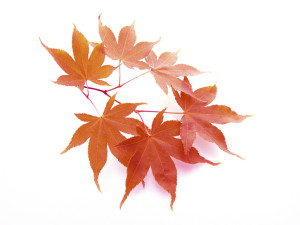Q. I recently purchased a red leaf Bloodgood Japanese Maple. My son says it should be planted in a shady area and it will grow to twenty feet unless it’s kept in a container. I want to plant it in a sunny location. Where should it be planted?
A. Your son is correct about the size of a Bloodgood Japanese Maple as they grow to twenty plus feet with a ten to twelve foot spread. A container does limit the ultimate height but so does an annual pruning for those planted in the landscape. However, he’s incorrect about the exposure. In the Bay Area, Japanese Maples are grown in full sun or part shade. It is typical for the red leaf maples, particularly Bloodgood, to loose their red color and turn green during the summer months. A sunny location extends the red coloring. In the fall, the Bloodgood foliage reverts to a reddish green color but they defoliate before they turn completely red. Red-leaved varieties get their color from a pigment called anthocyanin. Anthocyanin is often displayed in the fall and winter months in other plants as the green pigment, chlorophyll, breaks down. The red pigment in maples disappears with warm temperatures and long days. The initial site selection is a key in maintaining the long-term foliage color. They shouldn’t be crowded into a corner and factor in how much more the landscape around it is going to mature in the next ten years. The location should provide some protection from hot dry winds or salt carried by the afternoon marine influence. The hot dry conditions cause the leaves to burn along the margins and tips particularly in the lace-leaf varieties. Another cause of tip burn is synthetic type fertilizers. A slow release organic fertilizer or one specifically for Japanese Maples is desirable. You can protect the foliage from the hot conditions with Bonide Wilt Stop. Wilt Stop will protect the foliage from the hot conditions just as it protects plants from freezing temperatures. Now is a good time to apply it before the really hot weather arrives.
Q. I recently dug up three dead bushes and noticed the soil had a lot of white stuff mixed in with it. Is it safe to plant in that area again?
A. It is common for a white fungus type growth to develop in our clay soils that are amended with organic matter. The white stuff has a stringy texture that can be matted or it looks like its weaving it way through the soil particles. It’s Mother Nature at work breaking down or composting the chunky pieces of organic matter in the soil. There is no need to be concerned although it is a bit of a surprise or for some a shock when noticed for the first time. You can replant whenever you like without any reservations.
Buzz Bertolero is Executive Vice President of Navlet’s Garden Centers and a California Certified Nursery Professional. His web address is www.dirtgardener.com and you can send questions by email at dirtgarden@aol.com or to 360 Civic Drive Ste. ‘D’, Pleasant Hill, Calif. 94523 and on Facebook at Facebook.com/Buzz.Bertolero
Leave a Reply